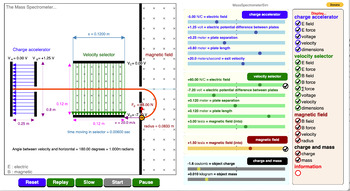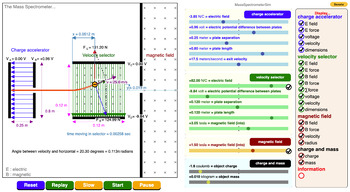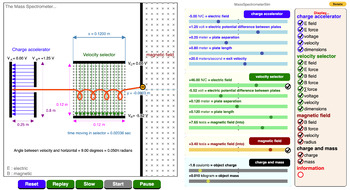Mass Spectrometer Simulation. Works in all browsers and iPads.
Sensible Science Simulations
6 Followers
Grade Levels
10th - 12th, Higher Education, Adult Education, Homeschool
Subjects
Resource Type
Standards
NGSSHS-PS2-5
NGSSHS-PS2-1
Formats Included
- Html Document File
- Internet Activities
Sensible Science Simulations
6 Followers
Compatible with Digital Devices
The Teacher-Author has indicated that this resource can be used for device-based learning.
Description
Mass Spectrometer Simulation:
The user can control almost every aspect of the device:
- All potential differences.
- The magnitude and direction of the electric fields.
- The magnitude and direction of the magnetic fields.
- The charge and mass of the accelerated object.
- The separation and size of the capacitor plates.
- The velocity at which the object leaves the ‘electron gun’.
The user can view the:
- Electric force on the object.
- Magnetic force on the object.
- Net force on the object.
- The speed at which the object is moving.
- Angle at which the object is moving.
- The time spent inside the velocity selector.
- The horizontal and vertical position of the object inside the velocity selector.
- The radius of the object’s path if it makes it through the selector in a straight line.
The user can choose to hide any aspect of the device.
The simulation is also very useful for simulating just the ‘electron gun’ , just the velocity selector, just the path of a charge in a uniform electric field, or just the path of a charge in a uniform magnetic field.
Total Pages
Answer Key
N/A
Teaching Duration
N/A
Report this resource to TPT
Reported resources will be reviewed by our team. Report this resource to let us know if this resource violates TPT’s content guidelines.
Standards
to see state-specific standards (only available in the US).
NGSSHS-PS2-5
Plan and conduct an investigation to provide evidence that an electric current can produce a magnetic field and that a changing magnetic field can produce an electric current. Assessment is limited to designing and conducting investigations with provided materials and tools.
NGSSHS-PS2-1
Analyze data to support the claim that Newton’s second law of motion describes the mathematical relationship among the net force on a macroscopic object, its mass, and its acceleration. Assessment is limited to one-dimensional motion and to macroscopic objects moving at non-relativistic speeds. Examples of data could include tables or graphs of position or velocity as a function of time for objects subject to a net unbalanced force, such as a falling object, an object sliding down a ramp, or a moving object being pulled by a constant force.




